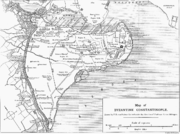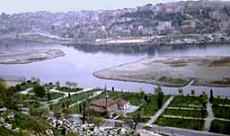

Golden Horn -
Halic
Go Back to Istanbul Subway Main Page

Seraglio Point (Sarayburnu) on the Golden Horn, as seen from the Galata
Tower
|
Boats on the Golden Horn
|
The Golden Horn (Turkish: Haliç or Altın Boynuz, Greek: Χρυσόν Κέρας Chrysón Kéras) is an inlet of the Bosphorus dividing the city of Istanbul and forming a natural harbor.

According to Greek legend, the Golden Horn derives its name from Keroessa, the mother of Byzas the Megarian, who named it after her. It forms a deep natural harbor for the pensinsula it encloses together with the Sea of Marmara. The Byzantine Empire had its naval headquarters there, and walls were built along the shoreline to protect the city of Constantinople from naval attacks. At the entrance to the Horn, there was a large chain pulled across from Constantinople to the old Tower of Galata (which was known as the Megalos Pyrgos (Great Tower) among the Byzantines) on the northern side, preventing unwanted ships from entering. This tower was largely destroyed by the Latin Crusaders during the Fourth Crusade (1204), but the Geneose built a new tower nearby, the famous Galata Tower (1348) which they called Christea Turris (Tower of Christ).
There were three notable times when the chain across the Horn was either broken or circumvented. In the 10th century the Kievan Rus' dragged their longships out of the Bosporus, around Galata, and relaunched them in the Horn; the Byzantines defeated them with Greek fire. In 1204, during the Fourth Crusade, Venetian ships were able to break the chain with a ram. In 1453, Ottoman Sultan Mehmed II, having failed in his attempt to break the chain with brute force, instead used the same tactic as the Rus', towing his ships across Galata into the estuary over greased logs.
After the Capture of Constantinople in 1453 by Mehmed the Conqueror, Greek citizens, the Greek Orthodox Church, Jews, Italian merchants, and other non-Muslims began to live along the Horn in the Phanar (Fener) and Balat districts. Today the Golden Horn is settled on both sides, and there are parks along each shore. The Istanbul Chamber of Commerce is also located along the shore, as are Muslim, Jewish and Christian cemeteries. The Galata Bridge connects the districts of Galata and Eminönü. Two other bridges, the Atatürk Bridge and the Haliç Bridge, are located further up the Horn. Until the 1980s the Horn was inquinated with industrial waste, but has since been cleaned up and is a popular tourist attraction in Istanbul because of its history and beauty.
The Golden Horn is a flooded prehistoric estuary.
In 1502 Leonardo da Vinci produced a drawing of a single span 720-foot (240 m) bridge over the Horn as part of a civil engineering project for Sultan Bayezid II. The vision was resurrected in 2001 when a small footbridge of Leonardo's design was constructed near Aas in Norway.
On May 17, 2006, it was announced that the prime minister of Turkey Recep Tayyip Erdoğan and the mayor of Istanbul Kadir Topbaş had decided to resurrect the Leonardo da Vinci Bridge project. The urban planning and feasibility studies of the project had started earlier, in 1999. After five centuries, Leonardo da Vinci's bridge will span the Golden Horn, becoming the first architectural project of the Renaissance genius to be realized in its original scale and its planned location.
The Turkish architect in charge of the construction is Bülent Güngör, known for the restoration of the Çırağan Palace, the Yıldız Palace, and the Sümela Monastery. The Bridge will be an exact copy of da Vinci's design, with a single span of 720-foot (240 m), a width of 8 metres, and a height above the Golden Horn of 24 metres, as shown on his sketches.

The Golden Horn, a horn-shaped estuary, divides European side of Istanbul. One of the best natural harbors in the world, the Byzantine and Ottoman navies and commercial shipping interests were centered here. Today, lovely parks and promenades line the shores. In the setting sun, the water shines a golden color.
Golden Horn was an old trading point and popular shoreline residential area during the Byzantine period, it was largely inhabited by Jewish immigrants from Spain during the Ottoman period. The mixtures of Armenians, Greeks, Gypsies and Turks living along its shores reflected the city's colorful mosaic. Since 1880 the famed Cibali cigarette factory has been operating there, which today is renovated to house a private university.
During the Ottoman period, in the first half of 18th century, Golden Horn was very rich of tulip gardens and green parks where upscale people used to come to relax, and row with their boats at the romantic sunset.
With the neglect borne of a population explosion in the 1950's and ineffective zoning laws, the once pristine Golden Horn became a churning cesspool of grey city-sewage and industrial waste. Only in the 1980's did a much needed urban clean-up begin. Polluting factories were cleared and proper sewage needs met. Now, its shores green once again, lovely parks, promenades, and playgrounds greet visitors. The water glistens golden in the sun again, perhaps not as brightly as before, but one step nearer to what the poets once described as "Sadabad", or "place of bliss".
At Fener, a neighborhood midway up the Golden Horn, whole streets of old wooden houses and churches date from Byzantine times. The Orthodox Patriarchy resides here. Eyup, a little further up, reflects the Ottoman style of vernacular architecture. Cemeteries sprinkled with dark cypress trees cover the hillsides. It is always busy here with pilgrims coming to the tomb of Eyup in the hope that their prayers will be granted. The Pierre Loti Cafe atop the hill overlooking the shrine is a wonderful place to enjoy the tranquility of the view having a traditional Turkish coffee or tea.
There was no bridge over the Golden Horn before the 19th century. Small boats provided transportation between the two shores. The first Galata Bridge, which connects present day Karaköy to Eminonü, was built in 1836, rebuilt in 1845, again in 1912, and lastly in 1993. The Unkapani (Atatürk) Bridge further up the Horn handles the flow of traffic between Beyoglu and Saraçhane. The third one over the Horn is called the Haliç Bridge.
Go Back to Istanbul Subway Main Page
Hop On Hop Off City Sightseeing Istanbul - City Tour - Ho Ho Points
![]()
Home |
Ana
Sayfa | All About Turkey |
Turkiye
hakkindaki Hersey | Turkish Road Map
| Historical Places in Adiyaman |
Historical
Places in Turkey | Mt.Nemrut |
Slide
Shows | Related Links |
Guest
Book | Disclaimer | Send a Postcard | Travelers' Stories |
Donate a little to help |
Istanbul Subways |
Adiyaman Forum
|
|